1998 PONTIAC BONNEVILLE oil change
[x] Cancel search: oil changePage 131 of 395
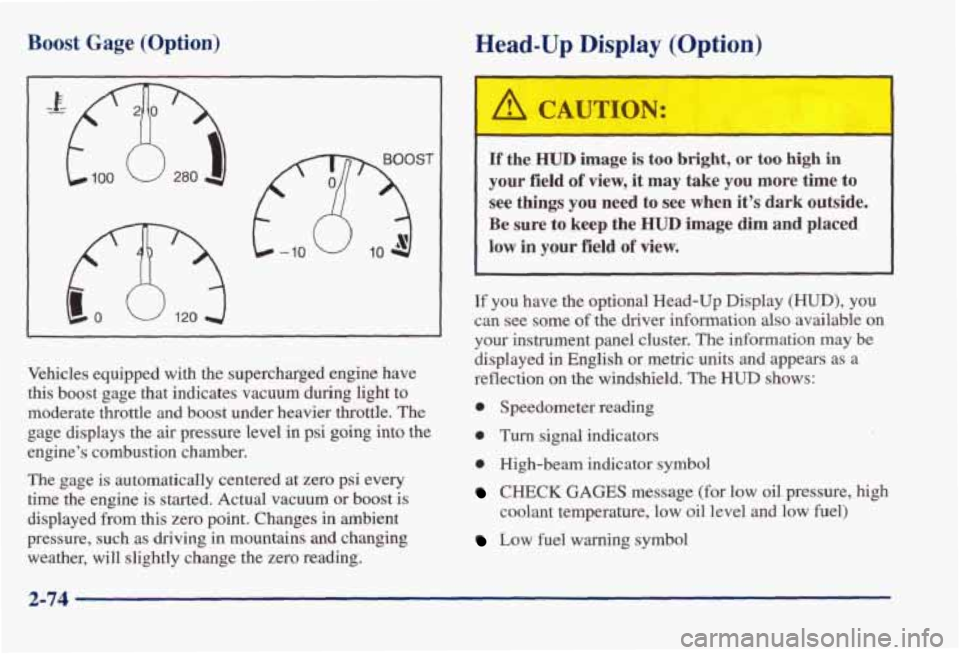
Boost Gage (Option) Head-Up Display (Option)
fXjST
Vehicles equipped with the supercharged engine have
this boost gage that indicates vacuum during light
to
moderate throttle and boost under heavier throttle. The
gage displays the air pressure level in psi going into the
engine’s combustion chamber.
The gage is automatically centered at zero psi every
time the engine is started. Actual vacuum or boost
is
displayed from this zero point. Changes in ambient
pressure, such as driving in mountains
and changing
weather, will slightly change the zero reading.
If the HUD image is too bright, or too high in
your field of view, it may take you more time to
see things you need to see when it’s dark outside.
Be sure to keep the HUD image dim and placed
low in your field of view.
If you have the optional Head-Up Display (HUD), you
can see some
of the driver information also available on
your instrument panel cluster. The information
may be
displayed in English or metric units and appears as a
reflection on the windshield. The
HUD shows:
0 Speedometer reading
0 Turn signal indicators
0 High-beam indicator symbol
CHECK GAGES message (for low oil pressure, high
coolant temperature, low oil level and low fuel)
Low fuel warning symbol
2-74
Page 266 of 395
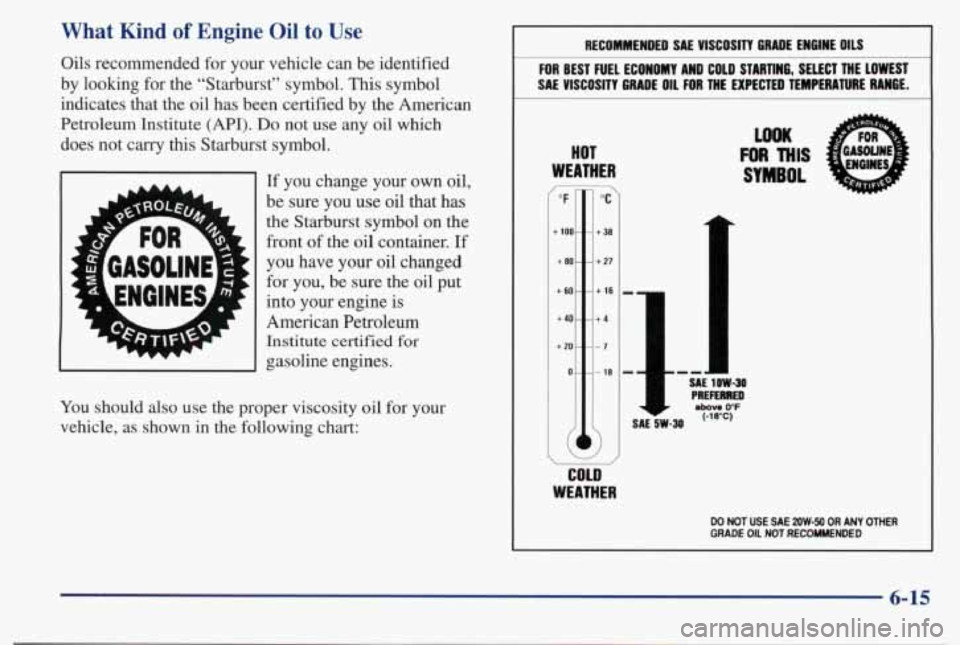
What Kind of Engine Oil to Use
Oils recommended for your vehicle can be identified
by looking for the "Starburst" symbol. This symbol
indicates that the oil has been certified by the American
Petroleum Institute
(API). Do not use any oil which
does not carry this Starburst symbol.
i A
If you change your own oil,
be sure you use oil that has the Starburst symbol on the
front of the oil container.
If
you have your oil changed
for you, be sure the oil put
into your engine is
American Petroleum
Institute certified for
gasoline engines.
You should
also use the proper viscosity oil for your
vehicle, as shown in the following chart:
RECOMMENDED SAE VISCOSITY GRADE ENGINE OILS
FOR BEST FUEL ECONOMY AND COLD STARTIN& SELECT THE LOWEST
SA€ VISCOSITY GRADE OIL FOR THE EXPECTED TEMPERATURE RAWGE.
HOT
WEATHER 7
"F
t 100 -
+80-
+60-
t40-
t 20 -
0-
7
"C
t3a
t
27
t 16
+I
-1
- 18
cou)
WEATHER
WOK
FOR THIS
SYMBOL
DO NOT USE SM 2QW-50 OR ANY OTHER GRADE OIL NOTRECaYlENMD
6-15
Page 267 of 395
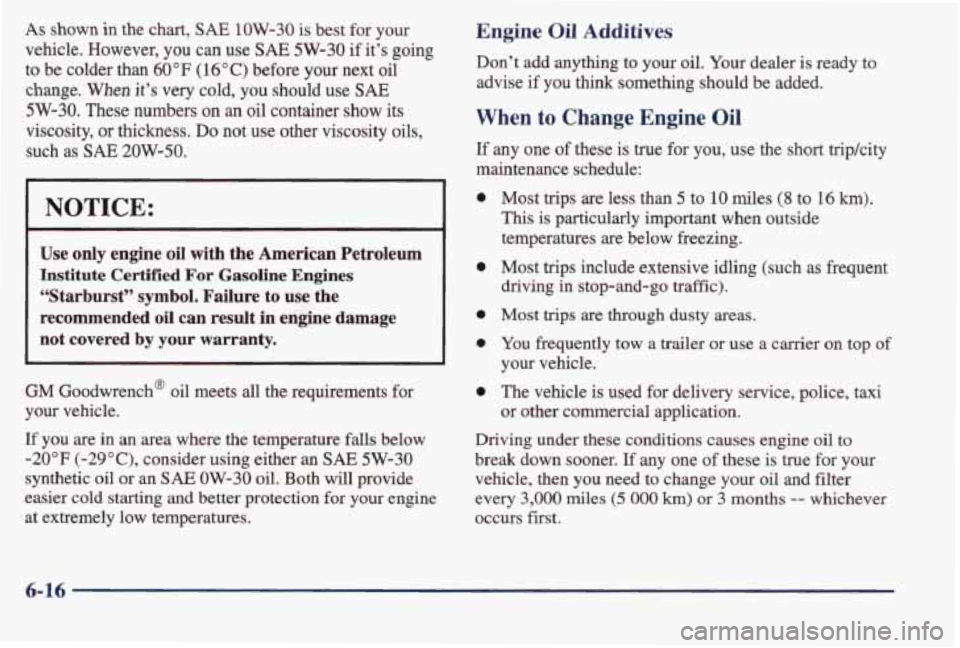
As shown in the chart, SAE 1OW-30 is best for your
vehicle. However,
you can use SAE 5W-30 if it's going
to be colder
than 60 "F (1 6" C) before your next oil
change. When it's very cold, you should use SAE
5W-30. These numbers on an oil container show its
viscosity,
or thickness. Do not use other viscosity oils,
such as
SAE 20W-50.
NOTICE:
Use only engine oil with the American Petroleum
Institute Certified For Gasoline Engines
"Starburst" symbol. Failure to use the
recommended
oil can result in engine damage
not covered by your warranty.
GM Goodwrench@ oil meets all the requirements for
your vehicle.
If you are in an area where the temperature falls below
-20°F (-29"C), consider using either an SAE 5W-30
synthetic oil or an SAE OW-30 oil. Both will provide
easier cold starting
and better protection for your engine
at extremely low temperatures.
Engine Oil Additives
Don't add anything to your oil. Your dealer is ready to
advise if you
think something should be added.
When to Change Engine Oil
If any one of these is true for you, use the short tripkity
maintenance schedule:
0
0
0
0
0
Most tsips are less than 5 to 10 miles (8 to 16 lun).
This is particularly important when outside
temperatures are below freezing.
Most
trips include extensive idling (such as fiequent
driving
in stop-and-go traffic).
Most trips are through dusty areas.
You frequently tow a trailer or use a carrier on top of
your vehicle.
The vehicle
is used for delivery service, police, taxi
or other commercial application.
Driving under these conditions causes engine oil to
break down sooner.
If any one of these is true for your
vehicle,
then you need to change your oil and filter
every
3,000 miles (5 000 km) or 3 months -- whichever
occurs
first.
6-16
Page 268 of 395
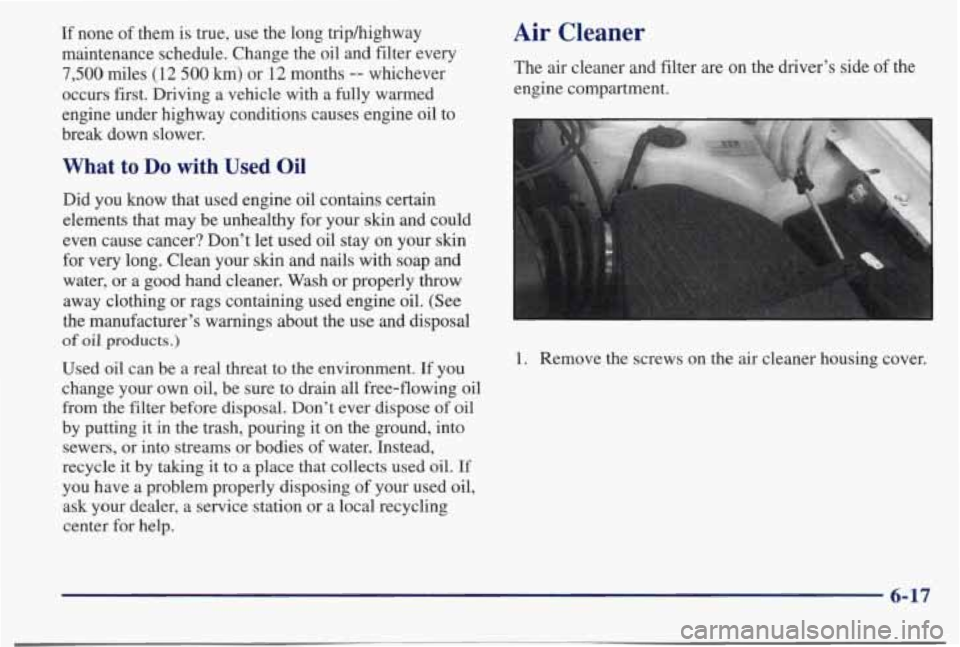
If none of them is true, use the long triphighway
maintenance schedule. Change the oil and filter every
7,500 miles (12 500 km) or 12 months -- whichever
occurs first. Driving a vehicle with a fully warmed
engine under highway conditions causes engine oil to
break down slower.
What to Do with Used Oil
Did you know that used engine oil contains certain
elements that may be unhealthy for your
skin and could
even cause cancer? Don’t let used oil stay on your skin
for very long. Clean your
skin and nails with soap and
water, or a
good hand cleaner. Wash or properly throw
away clothing or rags containing used engine oil. (See
the manufacturer’s warnings about the use and
disposal
of oil products.)
Used oil can be a real threat to the environment. If you
change your own oil, be sure to drain all free-flowing oil
from
the filter before disposal. Don’t ever dispose of oil
by putting it in the trash, pouring it on the ground, into
sewers, or into streams or bodies of water. Instead,
recycle
it by taking it to a place that collects used oil. If
you have a problem properly disposing of your used oil,
ask your dealer, a service station or a local recycling
center for
help.
Air Cleaner
The air cleaner and filter are on the driver’s side of the
engine compartment.
1. Remove the screws on the air cleaner housing cover.
6-17
Page 271 of 395
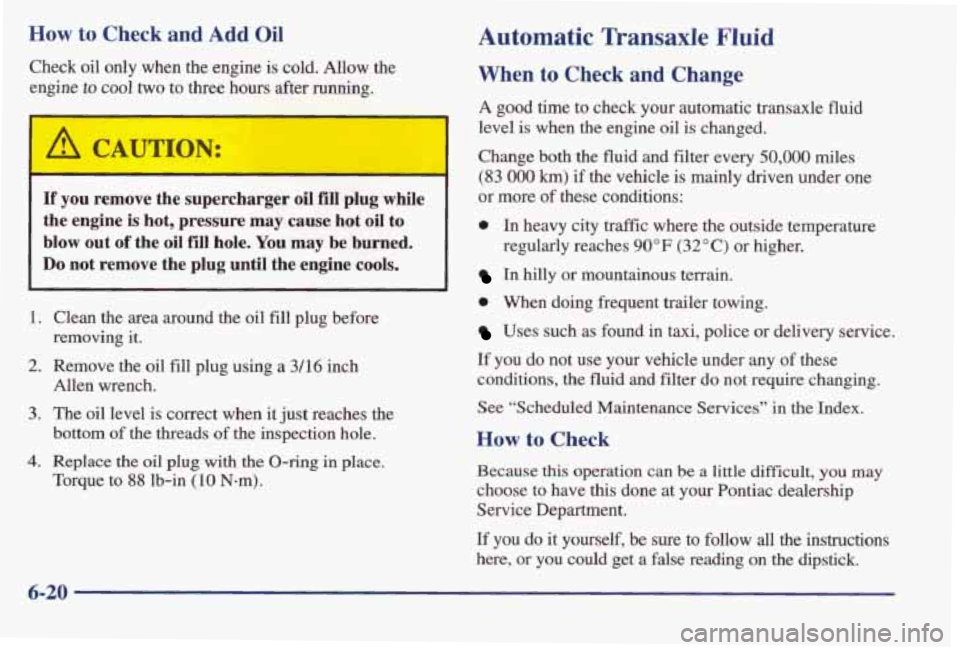
How to Check and Add Oil
Check oil only when the engine is cold. Allow the
engine
to cool two to three hours after running.
If you remove the supercharger oil €ill plug while
the engine
is hot, pressure may cause hot oil to
blow out
of the oil fill hole. You may be burned.
Do not remove the plug until the engine cools.
1. Clean the area around the oil fill plug before
2. Remove the oil fill plug using a 3/16 inch
3. The oil level is correct when it just reaches the
bottom of the threads of the inspection hole.
4. Replace the oil plug with the O-ring in place.
Torque to
88 lb-in (10 N-m).
removing it.
Allen wrench.
Automatic Transaxle Fluid
When to Check and Change
A good time to check your automatic transaxle fluid
level is when the engine oil
is changed.
Change both the fluid and filter every
50,000 miles
(83 000 km) if the vehicle is mainly driven under one
or more of these conditions:
0 In heavy city traflic where the outside temperature
regularly reaches
90°F (32°C) or higher.
In hilly or mountainous terrain.
0 When doing frequent trailer towing.
Uses such as found in taxi, police or delivery service.
If you do not use your vehicle under any of these
conditions, the fluid and filter do not require changing.
See “Scheduled Maintenance Services” in the Index.
How to Check
Because this operation can be a little difficult, you may
choose to have
this done at your Pontiac dealership
Service Department.
If you do it yourself, be sure to follow all the instructions
here, or you could get
a false reading on the dipstick.
6-20
Page 274 of 395
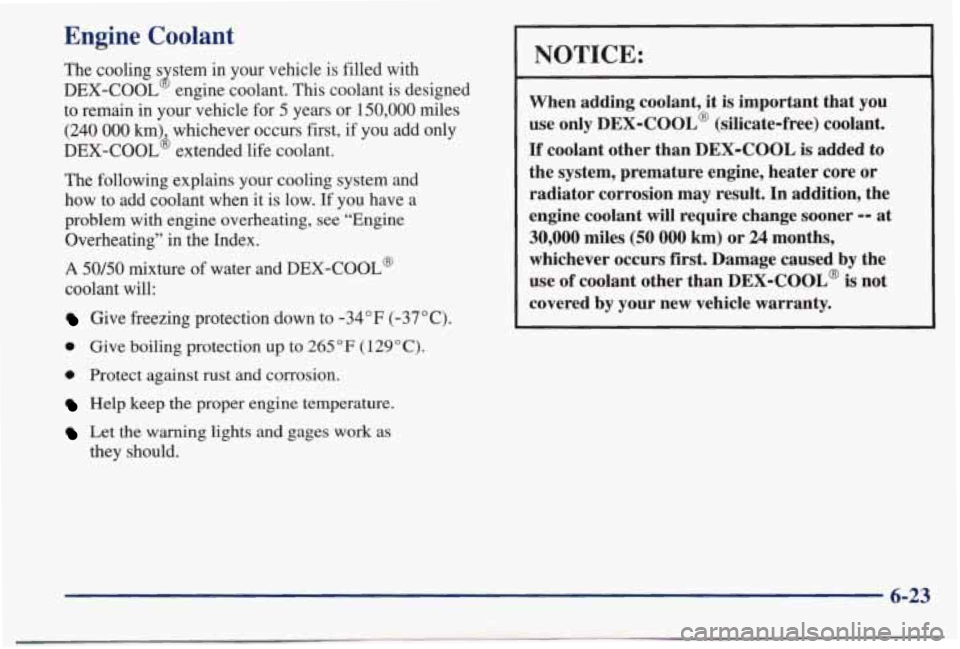
Engine Coolant
The cooling s stem in your vehicle is filled with
DEX-COOL
8 engine coolant. This coolant is designed
to remain in your vehicle for
5 years or 150,000 miles
(240 000 km) whichever occurs first, if you add only
DEX-COOL’ extended life coolant.
The following explains your cooling system and
how to add coolant when it is low. If you have a
problem with engine overheating,
see “Engine
Overheating”
in the Index.
A 50/50 mixture of water and DEX-COOL@
coolant will:
Give freezing protection down to -34°F (-37°C).
0 Give boiling protection up to 265 “F (129°C).
0 Protect against rust and corrosion.
Help keep the proper engine temperature.
Let the warning lights and gages work as
they should.
NOTICE:
When adding coolant, it is important that you
use only DEX-COOL@ (silicate-free) coolant.
If coolant other than DEX-COOL is added to
the system, premature engine, heater core or
radiator corrosion may result. In addition, the
engine coolant
will require change sooner -- at
30,000 miles (50 000 km) or 24 months,
whichever occurs first. Damage caused by the
use of coolant other than DEX-COOL@
is not
covered by your new vehicle warranty.
6-23
Page 300 of 395
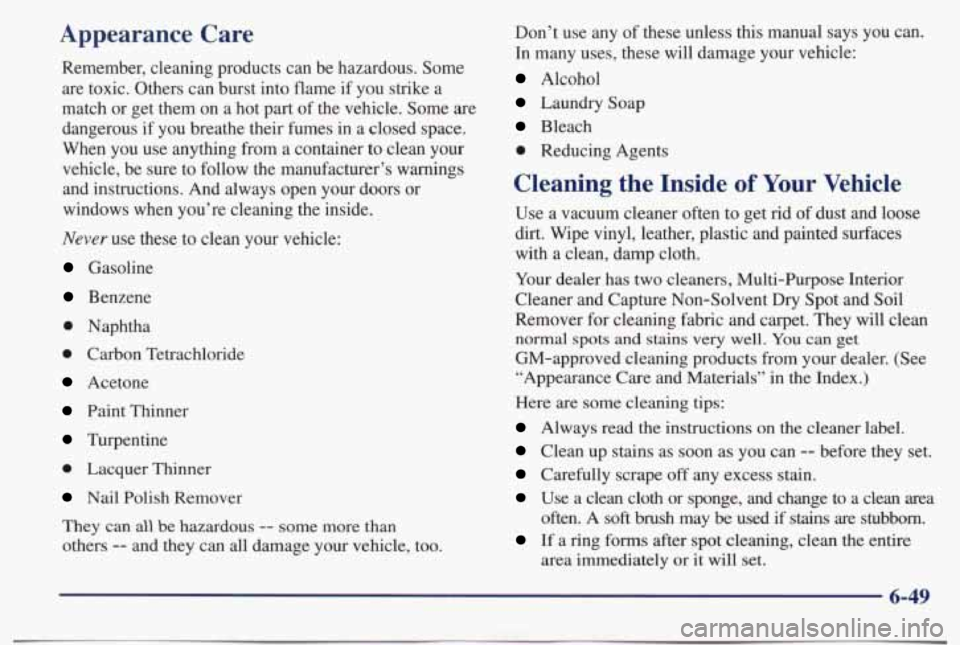
Appearance Care
Remember, cleaning products can be hazardous. Some
are toxic. Others can burst into flame if you strike a
match or get them on a hot part of the vehicle. Some are
dangerous if you breathe their fumes in a closed space.
When you use anything from a container
to clean your
vehicle, be sure to follow the manufacturer’s warnings
and instructions. And always open your doors or
windows when you’re cleaning the inside.
Never use these to clean your vehicle:
Gasoline
Benzene
0 Naphtha
0 Carbon Tetrachloride
Acetone
Paint Thinner
Turpentine
0 Lacquer Thinner
Nail Polish Remover
They can all be hazardous -- some more than
others
-- and they can all damage your vehicle, too. Don’t
use any
of these unless this manual says you can.
In many uses, these will damage your vehicle:
Alcohol
Laundry Soap
Bleach
0 Reducing Agents
Cleaning the Inside of Your Vehicle
Use a vacuum cleaner often to get rid of dust and loose
dirt. Wipe vinyl, leather, plastic and painted surfaces with a clean, damp cloth.
Your dealer has two cleaners, Multi-Purpose Interior
Cleaner and Capture Non-Solvent
Dry Spot and Soil
Remover
for cleaning fabric and carpet. They will clean
normal spots and stains very well. You can get
GM-approved cleaning products from your dealer.
(See
“Appearance Care and Materials” in the Index.)
Here
are some cleaning tips:
Always read the instructions on the cleaner label.
Clean up stains as soon as you can -- before they set.
Carefully scrape off any excess stain.
Use a clean cloth or sponge, and change to a clean area
If a ring forms after spot cleaning, clean the entire
often.
A
soft brush may be used if stains are stubborn.
area immediately
or it will set.
6-49
Page 316 of 395
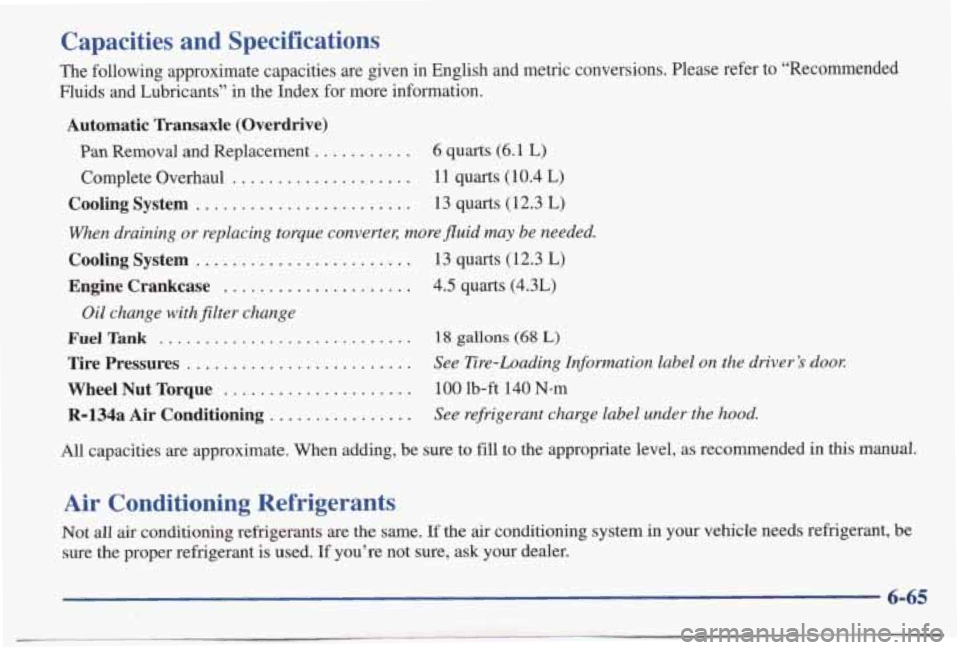
Capacities and Specifications
The following approximate capacities are given in English and m\
etric conversions. Please refer to “Recommended
Fluids and Lubricants” in the Index for more information.
Automatic Transaxle (Overdrive)
Pan Removal and Replacement ........... 6 quarts (6.1 L)
Complete Overhaul .................. 11 quarts (10.4 L)
Cooling System ........................ 13 quarts (12.3 L)
When draining or replacing torque converter; more fluid may be needed.
Cooling System ................ ........ 13 quarts (12.3 L)
Engine Crankcase ................... 4.5 quarts (4.3L)
Fuel Tank ............................ 18 gallons (68 L)
Tire Pressures .... >.. . See Ere-Loading Information label on the driver’s dool:
Wheel Nut Torque ......... . 100 lb-ft 140 N-m
R-134a Air Conditioning .... . See refrigerant charge label under the hood.
Oil
change with filter change
.......
.......
.......
All capacities are approximate. When adding, be sure to fill to the appropriate level, as recommended in this manual.
Air Conditioning Refrigerants
Not all air conditioning refrigerants are the same. If the air conditioning system in your vehicle needs refrigerant, be
sure the proper refrigerant is used. If you’re not sure,
ask your dealer.
6-65